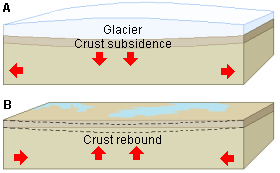On Wednesday 31 October 2012, slightly before 4.00 pm GMT, the British Geological Survey recorded a Magnitude 2.7 Earthquake 7 km beneath the Isle of Jura, south of Loch a' Gharbh-uisge and north of Loch Tarbert. Such a small quake is unlikely to have caused any notable damage and quite often will pass unnoticed, though on this occasion the quake was apparently felt on the neighboring Isle of Islay.
Map showing the location of the 31 October 2012 Earthquake. Google Maps.
It is not usually possible to judge the precise causes of Earthquakes in the UK, as the country is subject to tectonic stresses from a number of different, remote, sources, and most quakes are probably the result of more than one of these. The UK (along with the rest of Eurasia) is being pushed to the east by the expansion of the Atlantic Ocean and to the north by the impact of Africa into Europe from the south. There are also lesser areas of plate expansion beneath the North Sea, the Rhine Valley and the Bay of Biscay, all of which exert some pressure upon UK rocks.
It is, however, possible to say that Earthquakes become more frequent as you move north and west within the UK, and that the west coast of Scotland is the most quake-prone part of the country, and an explanation can be offered for this. During the last Ice Age, which ended about 10 000 years ago, much of the north of the UK was covered by a thick layer of glacial ice, which pushed the rocks of the lithosphere down into the underlying mantle. This ice is now gone and the rocks are springing back into position, albeit rather slowly, and this is happening at a faster rate in western Scotland than elsewhere in the UK. It is not usually possible to say that particular quakes are caused by glacial rebound, as the areas where this is occurring are still subject to tectonic forces from elsewhere, but it is certainly possible to say that there are more quakes in areas where the rebound is the strongest.
(Top) Simplified diagram showing principle of glacial rebound. Wikipedia. (Bottom) Map showing the rate of glacial rebound in various parts of the UK. Note that some parts of England and Wales show negative values, these areas are being pushed down slightly by uplift in Scotland, as the entire landmass is quite rigid and acts a bit like a see-saw. Climate North East.
Witness statements can help scientists to understand Earthquakes and the processes that cause them, if you felt this quake (or if you were in the area but did not, which is also useful information) then you can report it to the British Geological Survey here.
See also Small Earthquake on the Isle of Mull, Earthquake in the Scottish Highlands, Earthquake near Dumfries, southwest Scotland, Two Earthquakes in Perthshire in two days and Earthquakes on Sciency Thoughts YouTube.
Follow Sciency Thoughts on Facebook.



